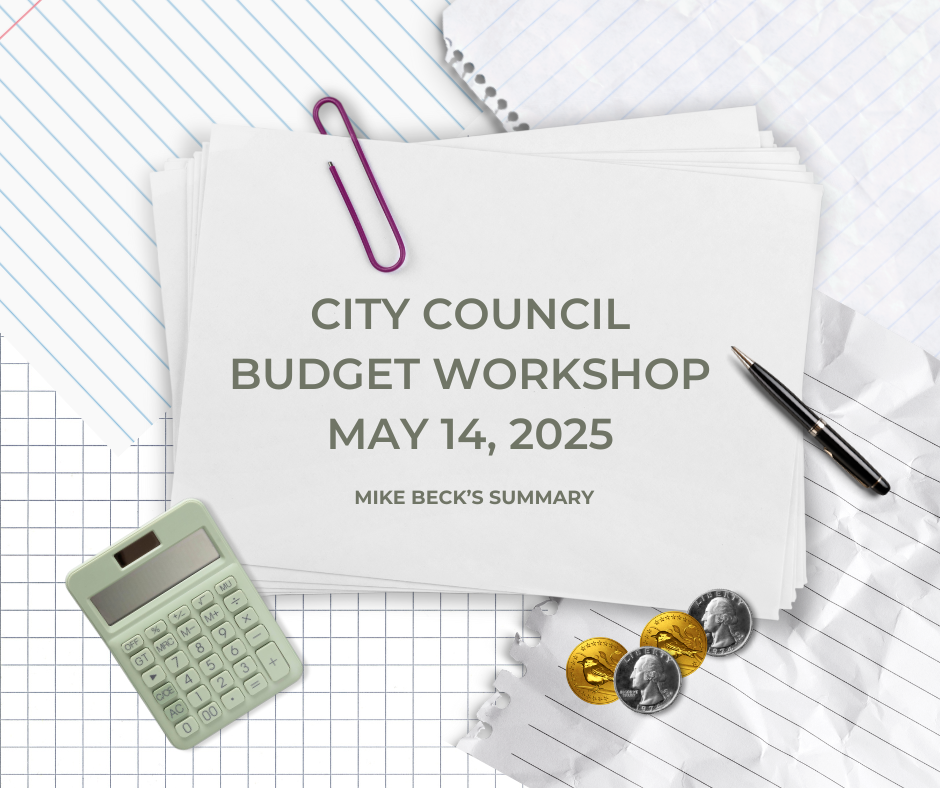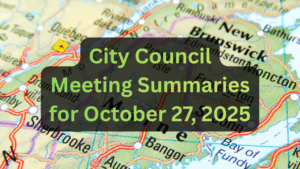
Disclaimer: The views I express here are my own and should NOT be construed as speaking for the City of Bangor or the City Council of Bangor.
City Council Budget Workshop Summary (May 14, 2025)
This blog post summarizes the key discussion points and budget considerations for various city departments as presented during the City Council Budget Workshop on May 14, 2025. Click here for the agenda for this workshop.
You can also see the entire Fiscal Year 2026 Bangor, Maine budget as proposed by the City Manager by clicking here.
Bangor Public Library
The library’s budget discussion focused on the inclusion of greeter positions, previously funded by an ARPA grant, into the base budget. These positions are considered mission-critical for managing behavior, crowd control, and providing a welcoming environment, though not mission-central in terms of traditional library services like handing out books. The greeter role is crucial for crowd control and misconduct management. The total cost for four part-time greeter positions is $53,200. Other budget increases are standard annual expense upticks.
Demonstrating careful management of funds and a desire to only request what is essential, the library also plans to run a $75,000 operating deficit. In a move that taxpayers will appreciate, this proactive measure means they are not asking the city to re-fund money that was allocated but ultimately not spent in the previous year.
Concerns were raised about the inter-library lending program and potential impacts from state funding uncertainties, though the $6,000 in federal pass-through funds for the current fiscal year has been received. A state government shutdown could halt inter-library loans statewide.
Police Department
The Police Department’s budget is heavily weighted towards personnel costs and necessary equipment. A significant announcement was that the department is fully staffed for the first time in 14 years, with communications staff also nearing full strength. This will allow for increased neighborhood presence and focus on community concerns like speeding. The department handles approximately 35,000 calls for service annually, with about a quarter involving individuals struggling in some way. The Bangor Community Action Team (BCAT) now handles about 1,200 calls a year and has expanded to six days a week. Most budget increases are tied to wages, with some increases related to transitioning the BCAT from federal COVID money to the general fund. A new program request is for a Public Information Officer to handle the more than 1,500 FOIA requests received annually. Vehicle replacement is a regular necessity, with an average patrol cruiser life of three to four years before hitting 120,000 miles. The department is also looking to upgrade technology, including body-worn cameras and potentially robots. Discussions also touched upon the cost of the city’s communication center versus potentially moving to a county system, with the current estimate for the city’s center being around $780,000 a year, not including the city’s cost for the county to maintain a separate system. The potential use of AI in dispatch, similar to Penobscot County’s AWS system, was discussed but met with mixed results so far. The department is also launching an unmanned aerial system (drone program) after receiving a grant, which is expected to be beneficial for accident reconstruction and searching for missing persons.
Parks and Recreation
The Parks and Recreation department manages a wide array of facilities and programs, including 31 parks (1,227 acres), pools, an ice arena, a semi-pro baseball stadium, community gardens, and all events on city public property (321 events last year). They are also a significant childcare provider. Most of this work is done by a small full-time staff (around a dozen people) with the support of part-time and seasonal employees. Challenges include maintaining open spaces and trails, and transitioning Mansfield Stadium back to city management. The department’s total budget is about $3.6 million, with roughly two-thirds related to personnel. A new program request is for a Recreation Sports Coordinator. Capital fund requests total about $1.2 million, with proposed funding of about $1.1 million, including a boiler replacement at the parks and rec center, tractors, mowers, vehicles, and playground structure replacements. The budget presumes the continued use of ARPA interest earnings to support public restrooms. Concerns were raised about the cleanliness and safety of current public restrooms, with a suggestion to divert funds from planned new restrooms to increase maintenance of existing ones.
Golf Course
The Golf Course operates as an enterprise fund, meaning it is self-sustaining and does not use taxpayer money; in fact, it pays fees back to the city. Interest in golf has renewed, partly due to the pandemic. The course offers an 18-hole and a 9-hole course, with about 60% of play being daily and 40% from members; memberships were sold out by mid-October. The course is Audubon certified. Challenges include attracting and retaining seasonal staff. Future plans include overhauling the junior golf program and renovating the Kelly 9 (named after original golf pro Austin Kelly). Most budget increases are personnel-related. No new programs were requested, but there’s consideration for clubhouse redesign and in-course improvements in the future.
Planning, Development, and Code Enforcement
This department encompasses planning, economic development, and code enforcement, including the 100% federally funded Community Development Block Grant (CDBG) program, which recently received $833,000. The average tenure of individuals in this department is one year, highlighting a rebuilding phase. Key activities include revamping CDBG policies, implementing a rental registry pilot program, marketing Bangor, reactivating the foreign trade zone, updating TIF policy, and retooling vacant property registration. Around 182 housing units have gone through the land development permitting process, and 17 commercial sites. Future goals include looking for warehouse opportunities, continuing to market city-owned properties, and attempting to reformat the Bangor Mall. There’s a push to move from manual to automated systems for code permitting, land use permitting, inspections, and licensing. Total expenses are about $1.7 million, with increases mainly due to personnel and retooling networking, event sponsorship, advertising, and marketing efforts. New program considerations include funding for the comprehensive plan, a sustainability intern, a housing development program (with a suggested $1 million), and potentially adding back an additional building inspector. The capital plan includes vehicle replacements and software funding.
Economic Development (Enterprise Fund)
This enterprise fund was created to acquire properties for redevelopment purposes and is staffed by the same personnel as Planning, Development, and Code Enforcement. The focus is on managing tenants, property management, freshening up development parcels for sale, and compiling decades of history. A major goal for the year is finalizing the design and operating plan for the central kitchen at 50 Cleveland Street. The operating budget primarily covers building repairs, maintenance, and some utilities, as personnel are paid from the general fund. The capital plan of about $6.3 million is mostly for the central kitchen.
Bass Park / Cross Insurance Center
Bass Park, deeded by the Bass family, primarily houses the Cross Insurance Center (convention and arena space) and also hosts the state fair and upcoming night markets. The grandstand, racetrack, and barns are leased to Penn National for horse racing operations. The Cross Insurance Center is focusing on tweaking in-house food offerings, has a nonprofit rate for its convention center, and saw increased attendance at the free Harvest Festival. The building is now 10 years old, requiring updates. Challenges include a downtick in national touring and competition from other local event spaces. Plans include a food truck alley for the fair and continuing to invest in equipment. The total operating cost is about $6.9 million, with around 40% being debt service for the arena construction and another third for personnel. The facility aims to cover its operating costs, with debt service funded through the downtown TIF and gaming revenue from the Arena Fund. Capital upgrades of about $225,000 are funded from TIF reserves and cover items like carpet, security improvements, and LED upgrades. A new program request, with a $25,000 contribution from corporate partner Oakview, is for a marketing and convention position.
Airport
The city owns and operates the airport, a large enterprise fund. Key projects include Phase Two of the runway rehabilitation and the recently opened 800-space parking lot which filled quickly. They are rolling out a common use solution for airlines and upgrading security access control. New services include Breeze Airways and seasonal Delta flights to Atlanta and Detroit. Canadian passengers typically make up 40% of traffic, so current travel uncertainties are being monitored. Passenger traffic continues at record-breaking levels. The total airport budget is about $25.5 million, with just under half related to wages and personnel. While landing and servicing fees for commercial airlines are increasing, military fuel sales are seeing a reduction (projected $1 million less in jet fuel sales). Parking and concession fees are increasing. The extensive capital plan includes replacing very old equipment (e.g., a 1955 tug and a 1976 fuel truck) and is funded through FAA grants (AIP), Bipartisan Infrastructure Law (BIL) funds, MDOT, Maine Air National Guard, and passenger facility charges (PFCs). No new programs were requested at this point. Cash reserves as of the meeting were $10 million, with investment accounts totaling $16.2 million.





